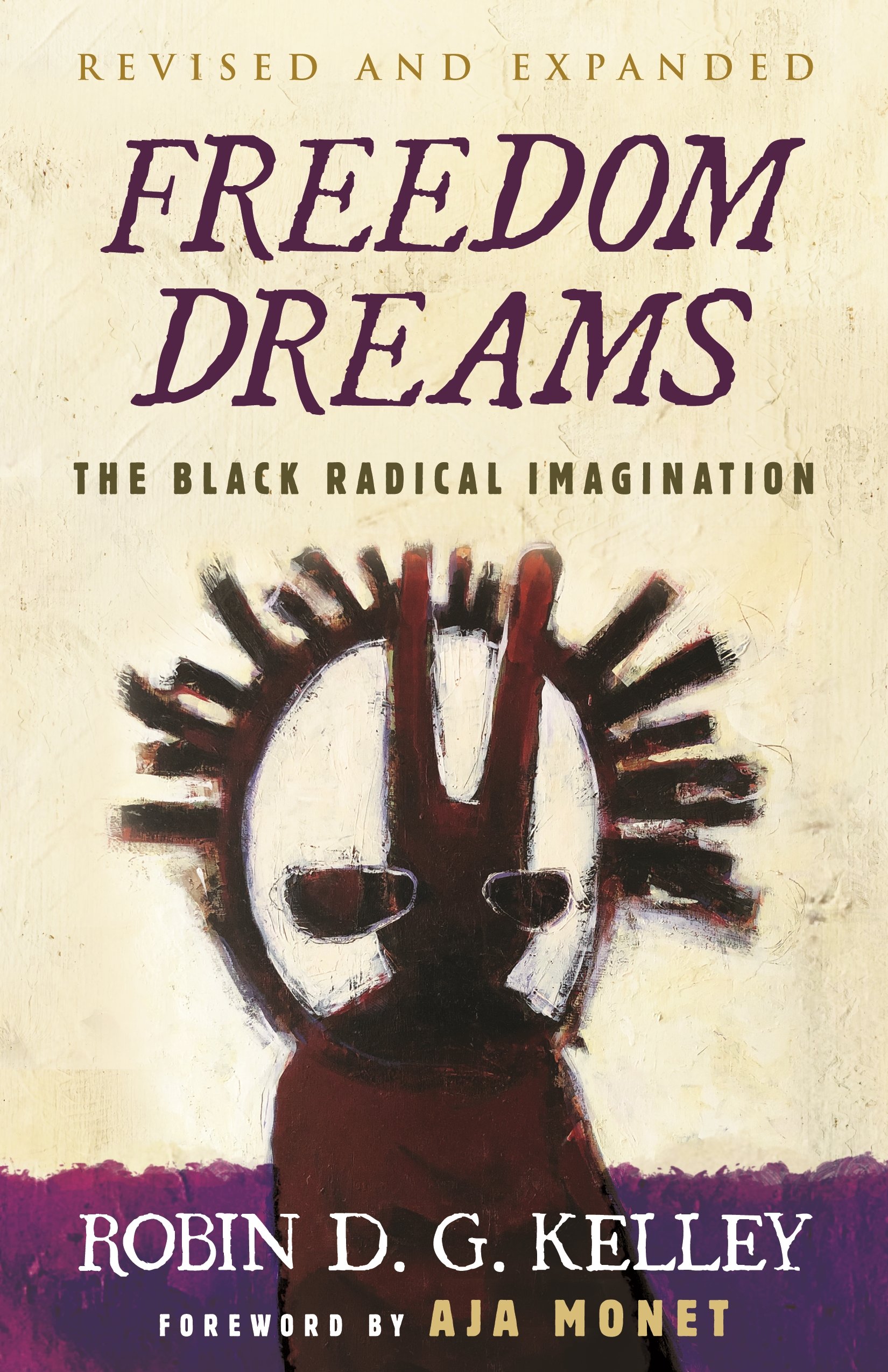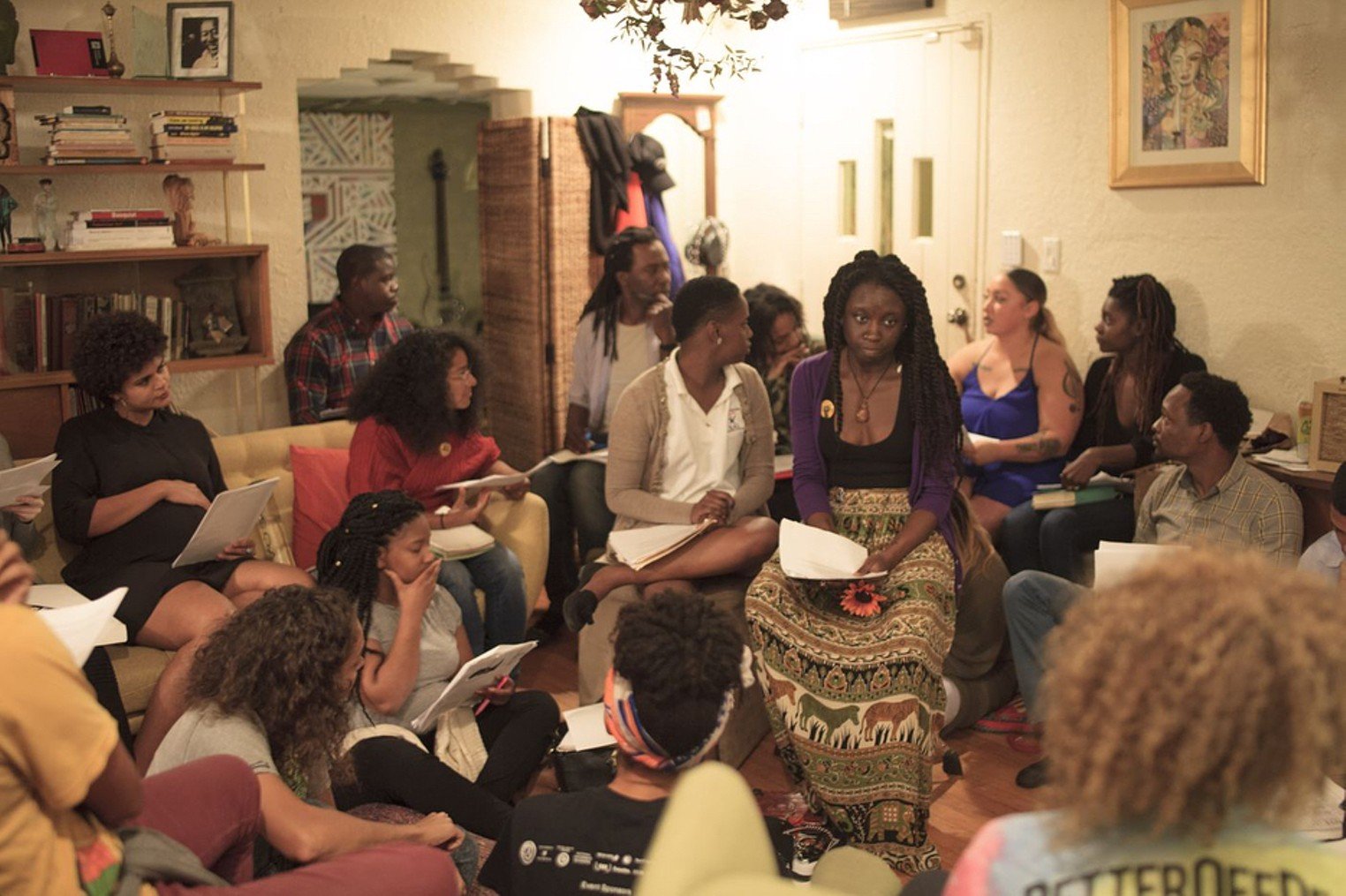
IN THE ORIGINAL epilogue of Freedom Dreams: The Black Radical Imagination, Robin D.G. Kelley writes,
But now is the time to think like poets, to envision and make visible a new society, a peaceful, cooperative, loving world without poverty and oppression, limited only by our imaginations.
This passage was a universal favorite at the University of Louisville’s Anne Braden Institute for Social Justice Research (ABI), where staff like me selected quotes for the weekly listserv email. No matter how many times we returned to these words, they felt like the warmth and spark of an old friend’s hug. I wanted to review the revised and expanded edition of Freedom Dreams just to encounter the above quote again, to meet it afresh at the end of the text and feel something move within my spirit. But it isn’t there—the new edition’s epilogue is different. The domestic conditions under which the respective editions were published? Not so much.
Robin D.G. Kelley penned the first edition of Freedom Dreams in 2001, when he was a professor of history and Africana Studies at New York University. The book began as a lecture in which Kelley meditated on hope, love, and the dreams of liberation among Black activists in radical social movements—concepts and visions seemingly forgotten in the protest politics of the new millennium’s dawn and all but crushed, alongside democracy, as the Supreme Court of the United States decided the 2000 presidential election and Congress chipped away at Americans’ civil liberties after 9/11. Kelley wanted to inspire new visions by articulating how Black radicals’ dreams, forged in struggle, had pushed communism, feminism, and surrealism in new, more inclusive directions. Twenty years later, as distinguished professor and Gary B. Nash endowed chair in US history at UCLA, Kelley found that renewed interest in Freedom Dreams was circulating, along with a free PDF version of the book as “Black Spring” took hold of the country. By winter 2020–2021, however, Black Lives Matter organizers on the frontlines were fatigued, sympathetic white people were acting out their fragility rather than their new antiracist knowledge, and white nationalists and neofascists had stormed the Capitol Building in an attempted coup. It was, again, time to remember that dreams of liberation were birthed during terrible times for Black people—time for an update to Freedom Dreams.
The epilogue of the 2022 edition is the one Kelley wrote more than twenty years ago, which he intended to include in the original 2002 edition. After 9/11, however, with Manhattan (then Kelley’s home) covered in smoke and dust and the US on its way to war with Afghanistan, his dream for a radically disrupted—though ultimately peaceful—future “felt uncomfortably apocalyptic” (2002). He closed instead “with a few brief reflections on where we might go from here,” pondering what phoenixes could rise from the “smoldering, desolate landfill” where the World Trade Center had stood, what could replace the former symbols of “global capital and consumer culture.” But when Kelley reread his original epilogue during the 2020 uprisings spurred by the murders of George Floyd, Breonna Taylor, and Ahmaud Arbery, it felt prescient.
My favorite line is absent from the new (original) epilogue, but the closing essay is still full of poetry and poets. In it, Kelley narrates a literal dream. Following protests over NYPD’s murder of Amadou Diallo in 1999, Kelley went to sleep and dreamed that uprisings against police brutality in New York organically birthed leaderless groups of Maroon Poets—young writers and other artists who imagined and organized “liberated zones,” spaces rooted in imagination, freedom, and love. The Maroon Poets, or MPs (I love the appropriation of this military abbreviation for freedom-loving purposes), eventually release a manifesto calling for the end of Western civilization and the violent, male, white supremacist mythology in which the world has been steeped for centuries. In Kelley’s dream world, the fascist “Law and Order Party” has won the presidential election, appointed an avowed Klan member as FBI chief, and declared a temporary dictatorship, but the MPs disrupt them with telepathic and kinetic superpowers. Finally, after one hundred years of civil war (Kelley revised this down from seven hundred years because the planet isn’t going to last that long), the MPs win. The entire US is a liberated zone.
I laughed out loud at parts of Kelley’s dream, not because they were unrealistic but because they were so joyfully surreal. Indeed, this edition of Freedom Dreams shows, from its first pages, how possible this vision is. In her foreword, surrealist blues poet, storyteller, and organizer Aja Monet describes as only a poet can how a gathering of writers, artists, and activists in Little Haiti led to the Maroon Poetry Festival in Liberty City, Miami. The gatherings, which eventually became the workshop Voices: Poetry for the People, were “sacred ground” in which, Monet writes, “we weren’t arguing, we weren’t triggered, we weren’t overwhelmed with grief.” The Maroon Poetry Festival was free, accessible, and intergenerational, and it offered health and educational resources alongside space to play and imagine. Kelley’s 2022 introduction names dozens of real-life MPs and the organizations they have founded since 2002, including several that center queer and trans liberation or decolonization and Indigenous thought—radical ideas he acknowledges he would thoroughly examine if rewriting Freedom Dreams today. (Chapters 1-6 are not rewritten.) Finally, Kelley introduces readers to actual present-day liberated zones in Jackson, Mississippi, and Detroit, Michigan, and to organizational and individual “MPs,” such as the Malcolm X Grassroots Movement, Dr. Gloria House, and Feedom Freedom Growers, who, as Kelley puts it, are “turning image into deed, turning poetry into action.”

In most chapters of Freedom Dreams, there is a clear vision of what liberation might look like in practice. In the first chapter, “Dreams of the New Land,” Kelley zooms in on Marcus Garvey’s Universal Negro Improvement Association to show how repatriation and Black-led domestic separatism movements reflect Black people’s desire to live safe from white violence and free from oppression. Other chapters focus on the efforts of Black socialists and communists to center Black workers as the fulcrum of an egalitarian society, and of feminist groups like the National Black Feminist Organization and the Combahee River Collective to expose gender oppression on the left and forge interconnected freedom movements. While discussing work by Aimé and Suzanne Césaire, Richard Wright, and Wifredo Lam, Kelley reveals how these and other artists have used surrealism to unshackle minds and envision a decolonized future.
By contrast, I found it challenging to grasp the vision of liberation in the third chapter, “‘Roaring from the East’: Third World Dreaming.” The chapter begins with Kelley’s assertion that “a vision of global class revolution led by oppressed people of color” emerged alongside and not out of the civil rights movement. Black American revolutionaries like Black Panther Party leader Huey P. Newton, NAACP leader-turned-leftist Robert Williams, and others studied the Chinese and Cuban communist revolutions for inspiration. The Revolutionary Action Movement (RAM), founded in 1962, interpreted the Black American freedom struggle as an anticolonial movement whose goals and philosophy were in sync with those of the Third World’s anticolonial movements. But I read thirty pages of this chapter before I really understood what these activists wanted out of the struggle: egalitarianism (except for women). I felt validated by Kelley’s suggestion that RAM may have had some misplaced priorities: “I think RAM activists were so concerned with self-defense and how to win militarily that they devoted little time and energy to the most fundamental question of all: what kind of world they wanted to build if they did win.” In his new introduction, Kelley goes further, confessing he had written the chapter “without ever questioning the romance of violent revolution, or the human costs of anti-imperialist wars.” This is ironic, given that, in his preface, Kelley understands love as one of “the most revolutionary ideas available to us” and “the heart” of matters of social justice. In other words, twenty years ago, he was aware of the love ethic that fueled his dreams, but love and war were siloed in his mind, as they usually are in practice.
I laughed out loud at parts of Kelley’s dream, not because they were unrealistic but because they were so joyfully surreal.
I, TOO, STRUGGLE with love as a concept in revolution. I’ve changed since I last read the first edition of Freedom Dreams, sometime between 2012 and 2015, while working at the ABI. The institute’s mission—to bridge the gap between social justice research and community activists who might use that research in their work for social change—eventually led me to the position I have now: director and architect of a project that brings poets, artists, and activists into institutional archives in Philadelphia, where, as fellows, they research their respective fields of activism and then present that research to their communities in an exhibition.
Any of these fellows could be Kelley’s MPs. Like groups and individuals in Detroit and Jackson, they have demanded safe communities for Black, brown, queer, trans, and poor people. They have remade neighborhoods by liberating abandoned lots from state neglect and repurposing them as community gardens, then fought off the resultant gentrification. They are much more interested in slow, iterative progressions and cultivating collective thought, conversation, and human relationship than they are in contractual language or commitments to funders.
And they have worn me out.
I’ve had ugly, verbally violent confrontations with some of the cohort. During one such conflict, several fellows waged personal attacks against me, and only one has apologized for their words. It hurt deeply. It harmed me. They framed their actions as calling me out, calling me in, or speaking truth to power and said they did it because they love me and want me to be a better human.
I share that experience in this review because it was the last thing I expected to have happen in a room full of people who are near my age and who self-identify as poets, artists, makers, organizers, activists, futurists, and dreamers. While I expected conflict to exist, I didn’t expect it to be fueled by ego or unhealed trauma and shame that some of my words and policies may have triggered. As I reread Freedom Dreams, my own work trauma prompted me to consider this question: Maybe love is what fuels radical movements, but love for whom? Love of what? In every visionary Kelley brings forward, I see a love for Black people. But in several of these agents, particularly the male revolutionaries of “Third World Dreaming,” I also see a love of—or at least an enduring infatuation with—ego, power, dominance, and armed force, patriarchal mores that continue to drive Black feminists and Black LGBTQ+ folk to imagine something better. Self-love is critical for Black people. As I’ve written elsewhere, “self-love in a world that hates you is one of the most subversive acts you can commit.” But when self-love is distorted into selfishness, it disrupts liberation and makes love hard to believe in.
Kelley also notes in “Third World Dreaming” that Robert Williams urged “all young black activists [to] ‘undergo personal and moral transformation’” as a step toward collective revolution. This was a call for discipline adopted from Maoist philosophy more than a suggestion to heal from trauma; nonetheless, Williams recognized the importance of personal growth. But after deep soul-searching, perhaps after therapy, there’s another step. As essayist and novelist Kiese Laymon says, “Collective freedom is impossible without interpersonal repair.” This 2022 updated version of Freedom Dreams doesn’t prescribe healing relationships to Black and brown people, but I can’t imagine a liberated future without that healing.

